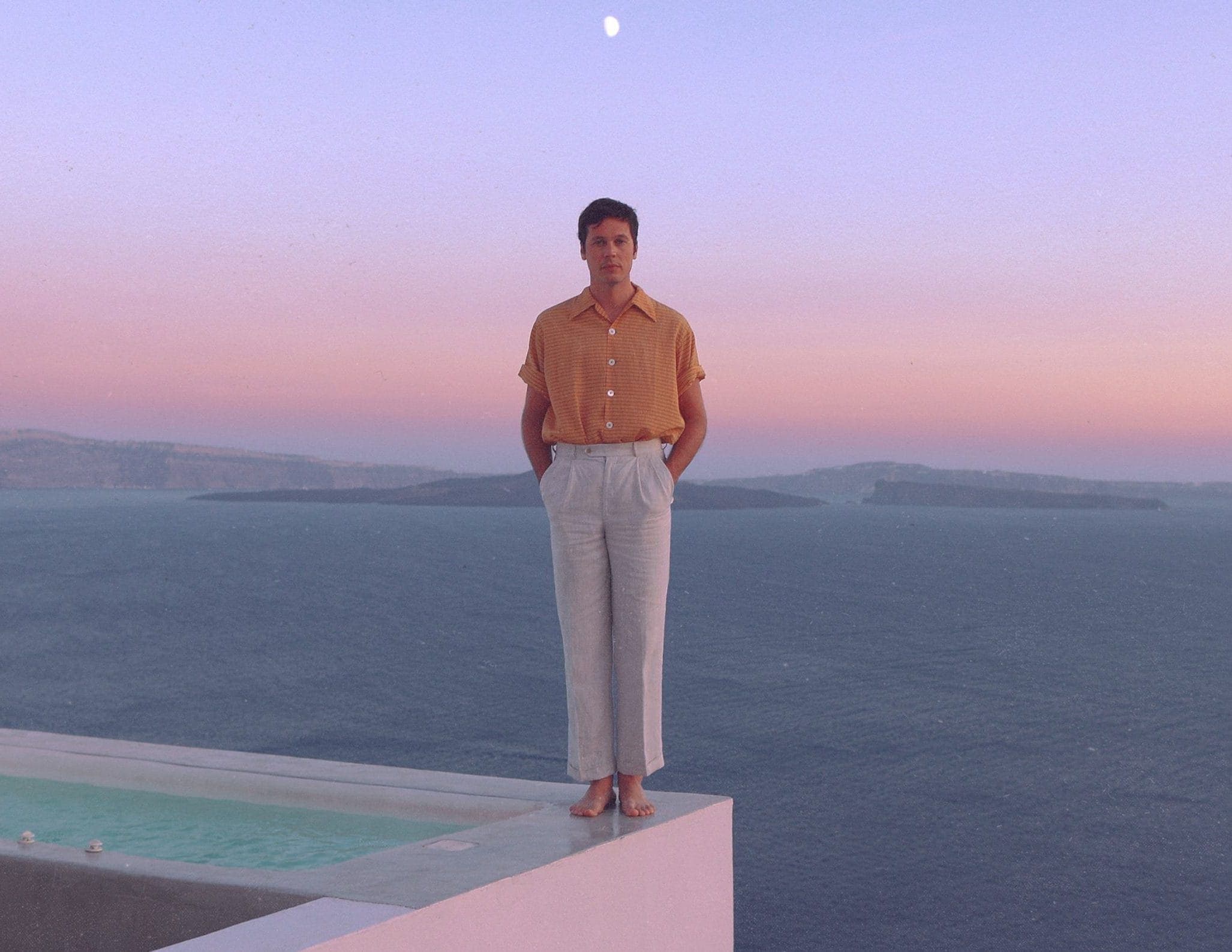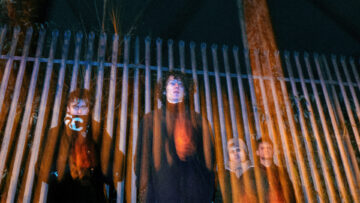

IN A SMALL CORNER of the internet, summer 2009 was dubbed the ‘Summer of Chillwave’, and hundreds of aspiring musicians were trying their hand at making retro, out-of-focus, escapist pop. So much so that by 2010 the chillwave movement was arguably over. But now, Washed Out’s just-released fifth album Purple Noon arrives in a very different summer indeed, and into a very different crisis to the 2007-8 financial crash. What can an album say about a decade?
ArrayA Confession
I FIRST ENCOUNTERED Washed Out, the Atlanta-based producer and songwriter, a decade ago. I was naive, precocious, and awkward. I wasn’t a writer, I wasn’t cool.
A boy in my seminar, though, was the epitome of both. Clad in plaid shirts off Brighton’s vintage racks and adjusting his Buddy Holly glasses, he wrote in crisp imitation of Brett Easton Ellis. He read Sartre. He listened to vinyls.
It was in his bedroom (the inner sanctum, how had I got myself invited round?) that I made a mental note of three posters pinned to the walls: Jim Jarmusch’s Mystery Train, Sufjan Stevens’ The Age of Adz, and Washed Out’s Within and Without.
When I got home that night, I discovered the music blogs Pitchfork and Gorilla vs. Bear. I swotted up. I was on an encyclopedia train to a very specific form of cultural capital. I had swallowed the hipster pill.

Such A Hipster
I DIDN’T CONSIDER MYSELF a hipster. But then, does anyone? It’s a label that other people brand you, when you give off an air of knowingness. When you adopt the rhetoric of the counterculture without the politics. When you listen to the ‘right’ music and buy the ‘right’ products, and you believe on some level that this marks you as transgressive.
For me — and I think, more generally — Washed Out has been bound up with hipsterism. The sketch comedy TV series Portlandia, which spoofed eccentric hipsters living in Portland, did a lot to solidify the link: Washed Out’s ‘Feel it All Around’ served as the theme song for its sepia-toned opening sequence.
‘Feel it All Around’ is thus perhaps the best-known track of the sardonically named subgenre ‘chillwave’ — a gauzy electro pop with lo-fi aesthetics, engaged with memory and nostalgia, and one of the first music genres to develop primarily through the internet.
This definitive song, ‘Feel it All Around’, samples ‘I Want You’ (1983) by Gary Low — and if you’ve never heard of it, that’s kind of the point. Chillwave is all about recovering relics from the past and warping them to dream of the future. Slowed down to the pace of floating, Washed Out’s repurposing of Low’s song sounds like brief and shimmering lens flare.
The track was made when Washed Out a.k.a. Earnest Greene was 26, unemployed, and living with his parents, in the aftermath of the financial crisis (2007-8). Greene uploaded the song to his MySpace page (!) and, through the alchemy of the internet, was picked up by London-based No Pain in Pop blog, and eventually by Pitchfork.
ArrayGrowing Pains
BUT CHILLWAVE HASN’T aged well. Nor has the hipster. Portlandia is as good a curio as any of the Obama administration: more frivolous days when lefties and progressives could enjoy a good brunch without having to think about politics or check their privilege; in any case, chillwave had arguably burned itself out long before Portlandia concluded in 2018.
A lot happens in a decade — not least our relationship to nostalgia (‘Make America Great Again’). While some practitioners of chillwave — like Toro y Moi and Neon Indian — branched off in new directions, Washed Out has only doubled down on the aesthetic.
My question is, does chillwave have a place in 2020? And, for that matter, does ‘chillness’?
Summer Haunting
ON THE ONE HAND, Washed Out’s latest album Purple Noon has perfect timing: because of the pandemic, people need escapism, we long for the beach — for songs that sound like sunshine itself and transport you elsewhere — and we’re nostalgic for an earlier time.
Plus, with more and more musicians confined to their homes, and with studios closed, we can probably expect more of the bedroom pop — popularised by the likes of Washed Out —to emerge: lo-fi production, coupled with fantasies of escape.
On the other hand, Purple Noon strikes me as precisely ten years out of date. Did Greene not get the memo that chillwave is dead? Perhaps he did. One track from Purple Noon is titled ‘Haunt’ (‘It all keeps coming back,’ Greene sings in barely discernible, heavily reverbed vocals). The song is minimalist, hushed, hazy, and full of space: the aural equivalent of walking along the shoreline of an empty beach at dusk.
Synths purr away, threatening to build up to something that never quite arrives. As such, I’m reminded of the soporific way that monotonous scenery passes on a long journey. Perhaps you’re on a train, or in a car, looking out the window — a tree passes, another tree, a field, field, tree — lulling you into a trance-like state, in which you can’t strictly be said to be looking; rather, the landscape is simply washing over you.
ArrayDude.
IN THIS SENSE, Purple Noon is guaranteed escapism. Yet, as much as I would recommend the album to anyone wishing to step out of these troubling times — pitching up instead in a neon cabana of hallucinatory brightness, where the wind is stroking your cheeks and the sand is smooth and anything but chafing — I also feel an overwhelming need to say sorry for even bringing it up. ‘Chillwave’. ‘Washed Out’. Why is that?
One of the reasons, probably, is that from the outset, ‘chillwave’ has been a biting, pejorative term. The anonymous influencer-cum-provocateur Carles, who ran the blog Hipster Runoff, came up with the name as a joke (he proposed a whole list, and that one stuck.)
As Norman Mailer noted in 1957, hipsterism originated in African American culture and was appropriated by white people; similarly, as Paul Rekret observes in Frieze, ‘chillness’ was ‘an aesthetic sensibility adopted by black American men striking a pose of detachment in the postwar era’, before it was embraced by white people seeking a rebellious posture. Meanwhile, ‘wave’ cynically implies a bankable trend.
Furthermore, a glance through the rest of Carles’ facetious name proposals for the subgenre (which includes ‘Music 2 smoke weed 2’, ‘Chill Bro Core’, ‘CumWave’, and ‘Browave’) suggests ‘chill’ was advanced with all its gendered connotations. As Emile Frankel notes in Hearing the Cloud, ‘chillness partly comes from the laid-back and desirable dude’.
Chillness is the guy invalidating your arguments by telling you: Just chill. Chillness, as an affect, subsumes all it touches, flattening out and denying all agency. Chillness is now also the guy sliding into your DMs for a ‘Netflix and chill’; though, back in 2009 the phrase had only just appeared on Twitter, without the sexual connotations which would become established in the early 10s.

To Sleep, Perchance To Dream
OF COURSE, THE PROGENITORS of ‘chillwave’ never asked for this name. Before Carles christened it so, both ‘glo-fi’ and ‘hypnagogic pop’ were used interchangeably to describe the nascent trend, which was branching off from the likes of Ariel Pink and James Ferraro. ‘Hauntology’ (meaning the return or persistence of things from the past, in the manner of a ghost) was another synonym used primarily in UK music journalism.
‘Hypnagogic’ refers to the transitional state from wakefulness to sleep. Indeed, with its slow-to-moderate tempos, woozy, warm and uncanny synth samples, this is the state that chillwave songs will put you in. Not ‘Music 2 smoke weed 2’, but aural tranquilisers in their own right.
Moreover, chillwave’s visual aesthetic is pacifying, too. Album artwork frequently shows calm seas; the sun dipping over the horizon line; unproblematic, minimalist geometric abstraction; faded chromatics in soothing pinks, purples, and blues. It’s artwork that would hang quite naturally in a therapist’s waiting room, or as the background image in a YouTube video titled ‘Powerful Ocean Wave Sounds for Deep Sleep’.
The album cover for Washed Out’s Purple Noon is exemplary: Greene stands barefoot on the ledge of a modern house with flat roofs (geometric abstraction). Behind him, a flat ocean. A gleaming, golf ball moon is suspended in the purplish hues of a tropical sunset. The scene is a pink and teal pastel fantasy from the 80s, only softened and subdued.
Likewise, the music video for ‘Time to Walk Away’, the first single off the album, boasts all the hallmarks of the chillwave aesthetic: summer is a place longed for from a quiet, hermetic place indoors (the image of dust motes eddying in a shaft of sunlight). Nature is fetishised and generalised (see the couple frolicking in the grass, the butterfly-shaped party lights). This world belongs to the coasting slacker (see the mattress on the floor, beer swigged from a bottle inside a paper bag.)
For all this semi-longed-for escapism, the lyrics are steeped in melancholy (‘Is it time to walk away?’) Yet the music keeps you on the surface, with the allure of genuine feeling beneath; this purported emotional intensity is always smothered — indeed, mellowed or chilled out — so that it merges with atmosphere, the general mood.
Then
GREENE’S MUSIC IS so often about indecision: where to go, what to do; being stuck in one place, while longing for elsewhere. Back in the late 00s, this was music for a generation of young people facing the post-recession job market. (Toro y Moi: ‘I found a job, I do it fine / Not what I want, but still I try’.) The fuzzy production values and grainy Polaroid filters were symptoms of a generational malaise.
Ironically, although this countercultural micro-movement seemed a yawning protest against the economic conditions it was produced in, it was co-opted by the market at hyper-speed. If a hipster is someone who buys into the trappings of a counterculture without living by its values, then the nascent ‘chillwave’ was catnip: a clearly demarcated (branded) and thus easily subscribed to aesthetic. At least it was for me.

NOW
WHILE CHILLWAVE HASN’T aged all that well, and chillness is problematic as an affect, Purple Noon has a welcome place in 2020. Though at first, the proposition is a bit like someone saying, ‘Coronavirus? Just chill out about it’, when viewed from a different perspective the album is thrown into stark relief: in ‘Too Late’, the second single and music video from Purple Noon, we get a snapshot of Washed Out’s listeners.
When filming was postponed for filming in Italy due to the pandemic, Greene put out a message soliciting footage from his fans. The result is a montage of horizons and coin-like, shimmering suns, overlaid and unfolding in one endless sunset.
Stitching together bruise- and peach-coloured clouds and falling light, but with no discernible filter, what we see is not so much a dream or a fantasy, but the chillwave aesthetic discovered and cherished in the frieze of everyday life. If chillwave mines the past to dream of a future, then these are fans building from the present.
Today, we’re more attuned to asking, ‘Who gets to dream, and why?’ Yet, for those who want to, Washed Out’s music presents a very specific architecture for a certain mode of dreaming. Purple Noon is suffused with melodramatic balladry, confusion, isolation and reconnection; it both holds up the mirror to our time, and a door, to step out of it.
While it might have surfaced, like a spectre from our recent past, Purple Noon is, by design, already a relic, a warped time-capsule (‘It all keeps coming back’). Then; now.
From a poster glimpsed in a student bedroom, from Bush to Trump, and from Blair to Johnson, who’d have thought that ten years later I’d still be trying to give up the ghost?




